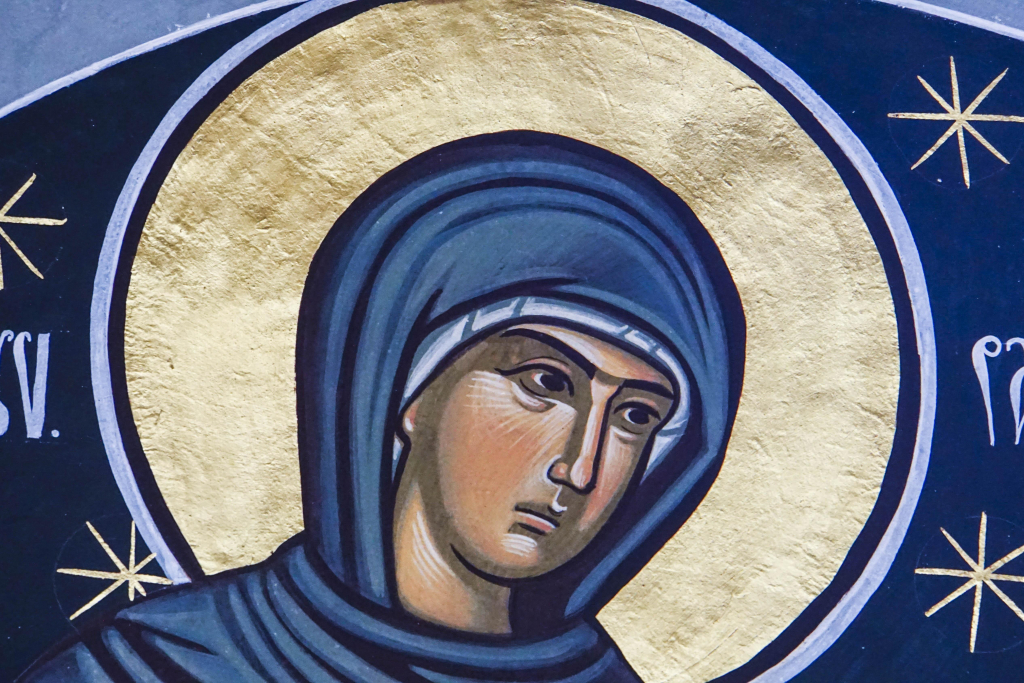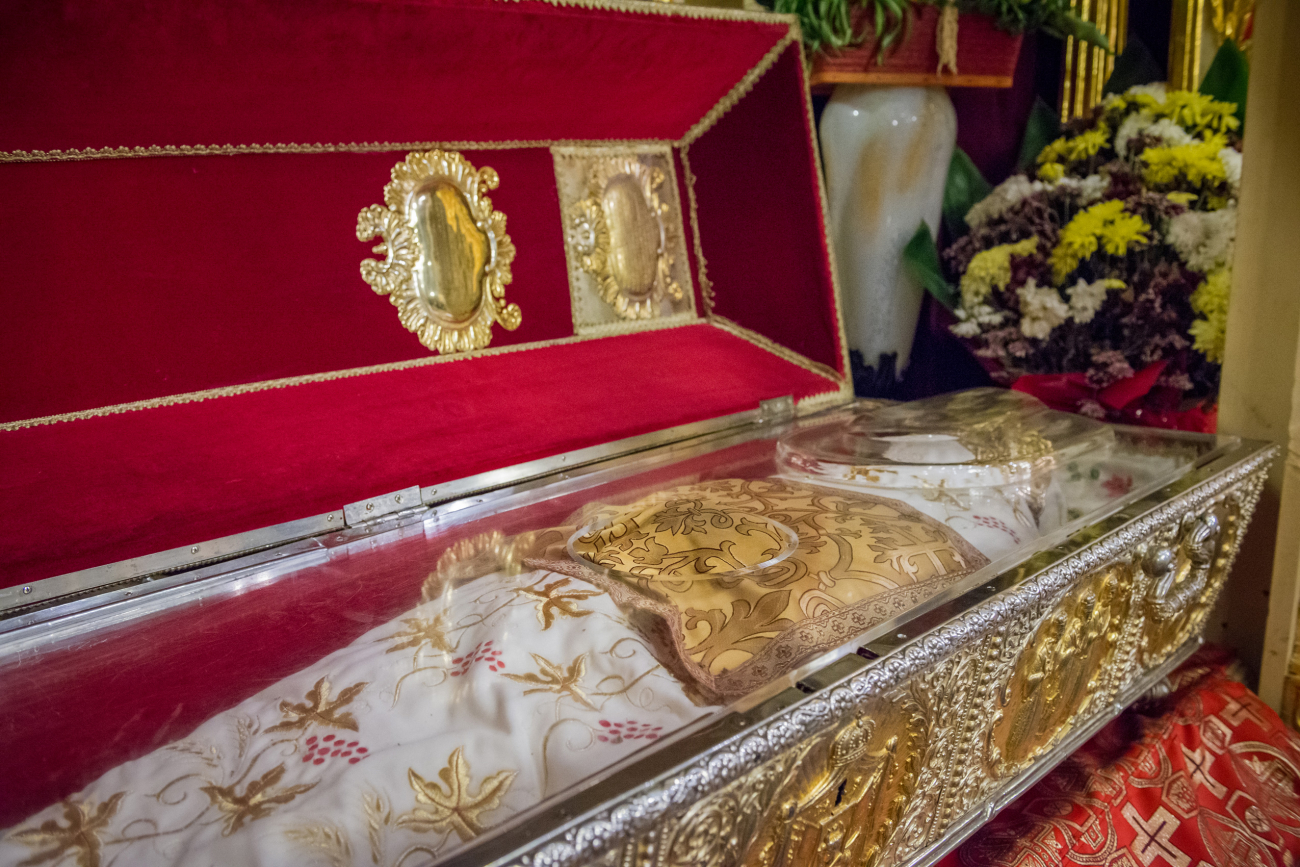Saint Parasckeve's Life
Every year, on October 14th, the Orthodox Church all over the world commemorates Saint Paraskeve. She is particularly venerated in Moldavia, as her relics have been in Ia[i, for more than 370 years already, a spring of blessings and spiritual and physical cures for those who call upon her intercession. If the Holy Martyr Paraskeve, vene-rated on July 26th in the orthodox calendar, is known popularly as “St. Friday”, the venerable Mother Paraskeve has been known, particularly in Mol-davia, as “The Great Friday”. As a symbol for the unity of Orthodoxy all over the world, Saint Paraskeve’s wonderworks after her passing to the Lord demonstrates how sainthood rises the one who has become like God from among his people, by making him or her a light for the love and bond between all those confessing and living the same faith. Evidence about the high esteem she was held in by our forefathers are the churches built in her honor, not only in Moldavia, but also in Transylvania and Wallachia.
Saint Paraskeve had her earthly sojourn during the first half of the 11th century. The first history of her life in Romanian can be found in the “Romanian Book of Teachings” (Cazania) by Metropolitan Varlaam of Moldavia, Ia[i, 1643.
She was born in Epibata (nowadays Selimpasa), on the shore of the Sea of Marmara, near Constantinople (later, Istanbul), the then capital of the Byzantine Empire. Her noble and devoted parents, always striving to live a holy life, have raised her in the fear of God, to do good deeds, to fast, to pray and give alms. One of her brothers, after his education, became a monk, Euthymios; he was elected bishop of the town of Madite for his love for God and his distinguished education.
Saint Paraskeve spent her childhood in the house of her caring parents. It has been said that, at the age of ten, “as she was in a church of our Most Holy Lady Theotokos”, she heard these words read aloud: "Whoever desires to come after Me, let him deny himself, and take up his cross, and follow Me" (Mk. 8, 34). The call of the Lord has put in her heart a desire to follow Him, so she gave all her clothes as alms to the poor. This she did also in other instances, disregarding the admonishment of her parents.
Heiress of great wealth, together with her brother, young Paraskeve gave the poor her part of the inheritance and, “leaving aside the beauty of this world”, withdrew “into the desert”. She made of Constantinople her first station, where she took advice from the wise monks and nuns there. Following their recommendation, she left the capital for Pontus after she passed through Chalcedon (Kadiköy). For five years she remained at the Theotokos Monastery in Heraklea. She left there to go to the Holy Land, wishing to spend the rest of her life in the places hallowed by the earthly sojourn of our Lord Jesus Christ and of the holy Apostles. After visiting Jerusalem, she settled at a convent in the Jordan desert, where she dedicated herself to a life of fasting and prayer, similarly to Saint John the Baptist, Saint Mary of Egypt or so many others who had likewise lived in such soul improving deserts. Saint Metropolitan Varlaam of Moldavia, in his Cazania, notes that, at this point in her life, St. Paraskeve did not care for “either clothes or sheets, food or supper, a home or servants, but alone for the purity of her soul and the answer to the Judgment to come”. She “wept constantly and relentlessly endeavored to better her soul, envisaging how she was to to become a fiancée to the heavenly Bridegroom, Jesus Christ, how she will rejoice at her Bridegroom’s appearance, thinking of the glory and the light and the unspoken bliss. For that… her eyes were always sunk in tears”.
One night, when she was about 25, an angel visited her in her sleep and told to return to the place of her parents: “Leave the desert and return to your land, because it is right for you to leave your body to the earth and pass away from this life to God, Whom you have loved”. After she had this vision, Paraskeve “unwillingly left the desert for the world and came to Constantinople”. Again and again she used to fall on her knees in the Church of St. Mary in Blachernae and in front of her icon she prayed in tears, saying “I have no other hope, I have no other support. You be my guide, you be my helper… For as long as I was in the desert I had you helping me, and now, as I have returned back to the world, steer me in the right direction until the end of my life, for I have no other hope”.
Leaving Constantinople, she went to Epibata, her native town, hiding from everyone who she was or where she was coming from. A storm almost caused the shipwreck of the boat. Then young Paraskeve cried „Kalikratei” (Strong courage). That is why according to tradition the place is named Kalikratea. In Epibata, resumes Saint Metropolitan Varlaam, “struggle over struggle and pain over pain she added, as she was bettering herself by fasting and keeping vigil, shedding tears and saying: Lord Jesus Christ, look down from your heavenly place, have mercy, Lord, tell the kind angel to take my soul untroubled. At peace with herself, the people and God, she thus gave her soul for eternal rest together with the heavenly Bridegroom.
She was buried like a stranger, as no one knew who she was. However, God, wishing to proclaim her holiness, miraculously revealed who the stranger was. It is said that a sailor had died on a ship and his body had been thrown into the sea. The waves brought it to the shore, and a hermit who was living there asked a few Christians to bury it according to the Christian custom. While they were digging a grave, they found Saint Paraskeve's body, uncorrupted and emanating a wonderful scent. In spite of this, they laid next to her the decaying body of the sailor.
During the next night, however, one of the Christians who had dug the grave, by the name George, had a dream in which an empress was sitting on a bright throne, surrounded by angels. One of the angels took his hand and said: George, why weren’t you considerate towards Saint Paraskeve’s body? Don’t you know that God has loved her goodness and has wanted to proclaim her state on earth? And the empress who he was seeing in his dream, who was none other than St. Paraskeve, ordered him to take her body immediately and lay it in some dignified place. The same vision was experienced by a devoted woman named Euthymia, in the same way and during the same night, and they both told everyone their wondrous tale.
The local faithful, hearing of the dream of the two, understood that it was a divine sign, so they took the holy body from the tomb and carried it with great joy, with lights and incense, placing it in the Holy Apostles Church in Epibata. At once, miracles happened following the prayers offered in front of the holy relics. It is said that the faithful in Epibata built a church on the place where her parents had lived and she herself had been born.
The news about the wonderworking of her relics spread soon all over Thrace and the Balkan Peninsula. It is likely that the Ecumenical Patriarchate swiftly recognized her holiness, listing her among the saints.
After her passing and the miraculous discovery of the holy relics, a number of writings about her brief life and the story of the transfer of her relics were composed. According to tradition, the oldest hagiographic word dedicated to Saint Paraskeve was written by Deacon Basiliscus, at the request of Patriarch Nicholas IV Mouzalon (1147-1151), around mid-12th century. Another history was written by the great patriarch Evtimii of Tarnovo, during the second half of the 14th century, who used, as did the later haghiographers, Deacon Basiliscus’ work. Metropolitan Matthew of Myra, who lived in the Dealu Monastery, near Targoviste, composed, in Greek, a new “Life”, as well as the service of Saint Paraskeve, around 1605. A few years later, her life was included by the great metropolitan Varlaam in his Cazania, printed in 1643. An Arabic version of her life was written by Macarios Ibn al Za’im, Patriarch of Antiochia. Metropolitan Dosoftei of Moldavia included a version of Saint Paraskeve’s life in his work “The Life and Passing of the Saints” (4 vols., Iaşi, 1682-1686), as well as in the editions of the “Menaion” published in the Romanian lands. Among the foreigners who studied her life we can count the well-known hagiographer St. Nikodemos of the Holy Mountain (1749-1809). Towards the end of the 19th century, the learned bishop of Roman, Melkisedec {tef\nescu (1823-1892), printed a work entitled “The Life and Miracles of Our Venerable Paraskeve the New and the History of Her Relics” (Bucharest, 1899). A few 20th century Romanian theologians took an interest as well in her life: Rev. Gh. P\v\loiu (1935), Archim. Varahil Jitaru (1942), D. St\nescu (1938), Rev. M. {esan (1955), Rev. Scarlat Porcescu, Rev. Prof. Mircea P\curariu et al.
After they rested in the church of Epibata for about two hundred years, performing numerous signs and miracles, the relics were moved to different places, due to the political turmoil in the Balkans. To all people, she proved to be of help in alleviating their troubles, a good and safe shore for all who venerated her and prayed for her intercession with the Most Merciful God.
The years 1185-1186 saw the Bulgarians and the Vlachs living south of Danube revolt from under the yoke of their two-century old domination of the Byzantine Empire, and create a new state, known as the Vlach-Bulgarian Empire, with Tarnovo as its capital. A few years later, in 1204, the western knights of the fourth crusade occupied the Byzantine capital, creating here a “Latin Empire of Constantinople”, which lasted until 1261, ruled by emperors coming from Western Europe. Under such circumstances, the Byzantines created two small empires, one in Asia Minor, with Nicaea as its capital, not far from Constantinople, and another one in Thessaly, with Thessalonica as its capital city. Due to the friendly relations between Emperor John Asan II of Tarnovo and the then emperor in Constantinople, in 1235 or just after that, St. Paraskeve’s relics were moved from Epibata to Tarnovo, the capital of the Vlach-Bulgarian Empire, a city who had become meanwhile the see of a patriarch. The transfer of the relics was made in a grandiose procession headed by Metropolitan Mark of Preslav, surrounded by many members of the clergy, welcomed everywhere with flowers, candles and services by the Vlach and Bulgarian faithful living south of Danube. In Tarnovo, Emperor John Asan II, his mother Helena, his wife Anna and the local patriarch came to receive the relics, which were laid to rest in the Church of Our Holy Lady Theotokos. It is said that the emperor built, near his residency, a church having St. Paraskeve as its patron saint.
The relics remained in Tarnovo for 160 years. It was probably then that the text of her service was written, which was incorporated in the “Menaion” for October. During the second half of the 14th century, Patriarch Evtimii of Tarnovo, probably a Vlach, wrote her life, including more details than existed in Deacon Basiliscus account.
However, around the same time, the Turks entered Europe. They conquered one by one significant parts of the Balkan peninsula. In 1393, they took the eastern part of the Vlach-Bulgarian Empire, including Tarnovo, and, three years later, also the western part, thus putting an end to this state.
In such grave circumstances for the Christians, Saint Paraskeve’s relics were moved to Vidin, then to Belgrade. There they stayed until 1521, when the Turkish armies took this city too, and Serbia became a vassal state. The relics were asked by the Ecumenical Patriarch from the sultan, who agreed to give them away for a price. The Patriarch decided they should be brought to Constantinople, the former capital of the Byzantine Empire (from 1453, the year of the Turkish occupation, known also as Istanbul). On their way to the great city founded by the emperor Saint Constantine the Great, the relics were exposed in many places for the faithful in the Turkish-ruled Balkan peninsula to be venerated. In Constantinople, at first, they were placed in the Church of Saint Mary Pammakaristos, the patriarchal cathedral of the time. After this one was turned into a mosque, the relics were moved to other churches: Blachernae (1586), Saint Demetrius (1597) and Saint George from the Fanar district (1601).
After 120 years, the holy relics had their latest move to date, this time to the Romanian lands. In 1641, after the right-believing prince Vasile Lupu of Moldavia paid all the debts of the Patriarchate of Constantinople, its head, Patriarch Parthenios I (1639-1644), together with the members of his Synod, decided to offer St. Paraskeve’s relics in gratitude, “for the consecration and blessing of that land of Bogdania (Moldavia)”, as one can read in the synodal letter: “Parthenios, by the mercy of God Archbishop of Constantinople, the New Rome and Ecumenical Patriarch(...) For the numerous charities and promises, following God's urges, of that bright and holy Prince, Our Humbleness together with the entire Holy Synod (...), being not able to find anything valuable and respectable to thank to this very Pious and Honorable Orthodox Prince as a reward for him and for the consecration of that land of Bogdania, have decided to give him the Holy Relics of our Venerable Mother Paraskeve the New (...)”
We understand from these that until May 1641 Vasile Lupu had paid a great deal of the debts of the Patriarchate and promised to pay the rest of them afterwards. In the library of The Holy Sepulchre Metochion of Constantinople one can find a few documents concerning the transfer of the holy relics:
a) The Synodal and Patriarchal Tomos, mentioned before, where Vasile Lupu’s demands are mentioned as well.
b)The original copy of Vasile Lupu’s Charter of August 20, 1641, which mentions the debts of the Ecumenical Patriarchate and the terms of the Prince.
c) Other princely and patriarchal documents about the payments made by the Moldavian Prince to the Ecumenical Patriarchate.
The reliquary with the holy relics was transported on the Black sea by ship, by a group of three Greek metropolitans (Ioanichios of Heraklea, Parthenios of Adrianople and Theophanes of Paleopatras). As they arrived first in Galati, then in Ia[i, they were welcomed by Prince Vasile Lupu, Metropolitan Varlaam and the bishops of Roman and Hu[i, by clergy and faithful. On June 13, 1641, the holy relics were laid to rest in the astounding church of the Three Hierarchs Monastery, erected by the prince himself. The relics remained there until 1884, when restoration work at the church was decided, and they were moved to the monastery chapel. On December 26, 1888, after Vespers, due to negligence, a candle remained to burn in the candlestick near the wooden reliquary; during the night, the candlestick burned thoroughly, and the fire moved towards the reliquary, slowly turning the wood into embers. The next morning, the state and church authorities, priests and faithful witnessed that the holy relics were untouched; it was yet another one of those miracles performed by the power of God. The bishop of lasting memory, Metropolitan Iosif Naniescu, took note himself of what happened in the chapel, praising the divine miracle. Leon Negruzzi, the prefect of Ia[i, as well as the general attorney, reported on the evidence. Lifted from among the embers, St. Paraskeve's relics were temporarily laid in the apse of the chapel of the Three Hierarchs Monastery and were soon after transferred to the new Metropolitan Cathedral of Ia[i, which had been consecrated not long before, on April 23, 1887. There they lay even today and are revered by the faithful, who ask St. Paraskeve for her intercession in the heavens, venerating her with devotion, for she is recognized to be the true protectoress of Moldavia.
During its session February 28, 1950, the Holy Synod of the Romanian Orthodox Church decided the canonization of a number of Romanian saints, as well as the generalization of worship for a few of the saints whose relics have their rest in our land. The said decision was set in motion during a great festivity during October 1955. In St. Paraskeve's case, the generalization of her worship was declared in the Metropolitan Cathedral of Ia[i, on October 14, 1955, in the presence of a good many Romanian hierarchs, as well as a few representatives of the Russian and Serbian Orthodox Churches.
The Orthodox faithful from all over the world show their devotion by means of their yearly participation to the services on October 14th, while the people of Ia[i and the neighboring region ask her in prayer every time they need help and protection. Venerable Saint Paraskeve is considered the undisputed protectoress of Jassy and the whole of Moldavia, for across the years the Moldavians felt in their lives the miraculous intervention of the divine grace brought about by the intercession of Venerable St. Paraskeve, the all-gracious to those in need.
Often, people from all over the country come to Ia[i in order to kneel in front of her relics, to give thanks for the help and blessing that brighten their lives.
Her pure life, defined by prayer and good deeds, her youth that shines across the centuries as does the light in the candles of the wise virgins are to us an incentive to pray and keep vigil more, to search for the joy brought to the heart by the presence of the Holy Spirit. A symbol for Orthodox brotherhood and the Light of Moldavia, St. Paraskeve brings us from her own century, a time of the One, undivided Church, hope to conquer over the passions, the divisions and the troubles of the world, by means of the simple and all-powerful love of Christ the Lord, Who loves and brings together all the people.
The Metropolitan Cathedral of Jassy was built on a site where two previous churches had existed: the White Church (15th c.) and the Stratenia Church (17th c.).
The present building owes its existence to Prince Ion Sandu Sturdza, whose decree of August 8, 1826 became its birth certificate, and to the resolve and the hard work of Metropolitan Veniamin Costachi (1803-1842), during whose episcopate the foundation stone was set in place and the construction process began, in 1833.
The Metropolitan Cathedral of Jassy has a neoclassical style, following plans drawn by the Viennese architects Johann and Gustav Freiwald. After a period of intense work, in 1841 serious concerns were raised whether the dome could bear its central, very large cupola. As a consequence, the work was halted for almost forty years.
Only at the end of the century, following the many requests by the Metropolitan Iosif Naniescu (1875-1902), the state authorities decided to resume the construction work at the metropolitan cathedral of Jassy. Thus, on April 15, 1880, after Architect Alexandru Or\scu of Bucharest redrew the plans, adding two rows of massive pillars to the interior, a second cornerstone was set. The large cupola that had been part of the earlier design was replaced by a system of four vaults, separated by transversal arches.
The new cathedral benefitted as well from a contribution by the renowned artist Gheorghe Tattarescu, who is the author of the interior frescoes and the various decorations of Renaissance influence, astonishing in their diversity and sensibility. The precision of Italian neoclassicism is felt in the realization of both the four biblical scenes on the vaults of the central nave and the portraits of the saints.
The dedication of the cathedral was a highly solemn moment that took place, in the presence of the royal family, on April 23, 1887. Carol I had endowed the cathedral with stained-glass windows made in Munich, as well as with chandeliers, candlesticks, silver censers and precious vessels and vestments.
The votive painting and the royal thrones are still present in the church today. The iconostasis, of an outstanding artistic excellence, was executed in Kiev, while the exterior mosaic above the entrance, depicting the scene of the Presentation of the Lord at the Temple, was made by the painter Gheorghe Raducanu of Bucharest (1929-1998).
Built in the Renaissance style, the cathedral is a monumental edifice with a rectangular plan and four out of parallel domes at corners. The architecture style is inspired by the Late Italian Renaissance, while the decorative elements of both the interior and the exterior belong to the Baroque.
The Metropolitan Cathedral of Jassy is today Romania’s most visited church by pilgrims, for here the holy relics of St. Paraskeve are held, after their transfer from their original home, the Three Hierarchs Church of Jassy. Next to these, a part of the relics of Saint George, brought from Livadia, Greece, are also presented for veneration.
St. Paraskeve is permanently visited by pilgrims, essentially for the immediate and wondrous support that she offers to those praying in front of her holy relics. The pilgrimage to Jassy, on account of the feast day of St. Paraskeve, on October 14th, is one of the largest in the Orthodox world. The Metropolitan Cathedral grows to be, as a consequence, a symbol of the spiritual bond between saints and of the spirituality of the Romanian people.






